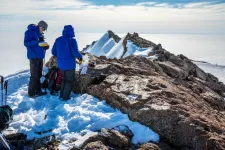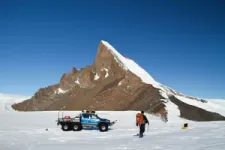(Press-News.org) Sixty per cent of the world's fresh water is bound up in Antarctic ice sheets. Thirty million cubic kilometres of ice is perhaps a difficult number to grasp. But if absolutely all Antarctica’s ice melted, the seas would rise by 58 metres on average.
“The ice sheet in East Antarctica stores enormous amounts of water. This means that this is the biggest possible source of future sea level rise – up to 53 meters if all of the East Antarctic ice melts – and is seen as the largest source of uncertainties in the future sea level adaptation planning,” says Irina Rogozhina, an associate professor at the Department of Geography at the Norwegian University of Science and Technology (NTNU).
Most melting/ice loss in Antarctica happens through ocean-driven melting of ice shelves and ice calving. This, in turn, leads to an acceleration of ice streams on land and a greater discharge of ice into the ocean, where it gets lost to melting/calving, she said.
This was also likely the cause of larger ice loss during warmer periods of the past. In Greenland, these two processes contribute about 65% of all ice loss.
But not all the ice needs to melt before it can have major consequences.
Researchers from NTNU were among a group of scientists who examined the ice in Queen Maud Land in East Antarctica. The results show that this ice sheet sector has varied a lot over time. This information is important as researchers try to learn more about the planet’s climate and how it is changing.
Rogozhina's group studied the ice sheet in East Antarctica and a meltdown that took place a few thousand years ago. The results have been published in the Nature journal Communications Earth & Environment.
The ice in the east lies on land
The ice sheet in Antarctica is not evenly distributed or uniform. In the west, large parts of the ice sheet lie under sea level, down to a depth of 2,500 metres. This makes it very vulnerable to ocean warming. In contrast, much of the ice sheet in the east sits directly on land, above sea level, meaning it is less sensitive to the ocean's influence.
This ice sheet sector in East Antarctica was thinner in the past than it is now, and not particularly long ago either. In fact, it was thinner following the end of the last ice age, when massive ice sheets previously covered North America, northern Europe and southern South America. When these ice sheets melted, they raised the sea level by more than 100 metres.
“From the evidence we presented in our study, we concluded that the East Antarctic ice sheet in Queen Maud Land also melted rapidly along its margins between 9,000 to 5,000 years ago, in a period we call the mid-Holocene. At this time, many parts of the world experienced warmer-than-present summers,” Rogozhina said.
"Although this kind of response by the East Antarctic ice sheet to the warmth during the Holocene is not completely unexpected, it is still difficult and worrisome to believe that the sluggish East Antarctic ice sheet can change so rapidly," she said.
It's difficult to find a simple, easy explanation for this behaviour, or to determine the exact timing when the melting took place, not least because the conditions in this part of the world are rather inhospitable at times.
But the researchers found a way to unravel this mystery.
Cosmic radiation changes rocks
The research group examined rocks from various nunataks in Queen Maud Land for exposure to cosmic radiation.
“Nunataks are mountains that stick up through the ice. We have visited nunataks and taken samples,” says Ola Fredin, a professor at NTNU's Department of Geosciences and Petroleum.
The researchers examine different isotopes, or variants, of elements such as chlorine, aluminium, beryllium and neon in rocks from the nunataks. With the help of cosmogenic isotopes, they can figure out how high the ice was over geological time in Queen Maud Land. Fredin compares this to using a dipstick to measure the level of engine oil in your car.
In this way, the researchers can say something about how long the rocks have been exposed to cosmic radiation. They can then also say something about how long it has been since the rocks have been under a protective layer of ice and thus have not absorbed any cosmic radiation.
For this, they use data from different areas and run a variety of computer simulations.
Rising seas and warmer water broke up the ice
The researchers also believe that they are on track to find a reason why the ice sheet sector in East Antarctica thinned so much immediately after the end of the last ice age.
“We believe that the ice sheet became less stable due to higher, regional sea levels and warmer water rising from the ocean depths in the polar regions, penetrating under the ice margins and melting them from below. This leads to the break-up of large icebergs and accelerates the movement of ice from the land to the ocean, which in turn thins the inland section of the ice sheet. The process is similar to when a house on a hill slope loses its supporting foundation and starts sliding downhill,” Rogozhina said.
In short, the less stable, rapidly flowing parts of the ice sheet in East Antarctica, which are called ice shelves and float on the ocean, were broken up more easily, which in turn led to the ice sheet becoming much thinner within a relatively short time, geologically speaking, or a few hundreds to thousands of years.
Thick ice is the most common along the coast
Cosmic radiation can also help researchers figure out how common it is for ice to cover an area. The researchers have also investigated this.
The results show that it is most common for the ice in Queen Maud Land to be thick along the coast. But not further into the continent, where mountain peaks protrude through the ice and the land can be several thousand metres high.
“We found that the land masses along the coast of Queen Maud Land have been covered by ice between 75 and 97 per cent of the time during the last one million years,” Fredin said.
He was part of another study, which has also had its results published in the Nature journal Communications Earth & Environment. This group examined rocks from several different areas in Queen Maud Land, and found great variations.
“In contrast to areas along the coast, which have been ice-covered most of the time, we find that mountain summits further into the continent have been ice-covered as little as 20 per cent of the time,” Fredin said.
The ice sheet thickness and movement speed therefore vary a great deal over longer periods, and the mountain range further into the continent seems to be an important division between the dynamic coast and the ice sheet further towards the South Pole, which varies much less in thickness.
References:
Suganuma, Y., Kaneda, H., Mas e Braga, M. et al. Regional sea-level highstand triggered Holocene ice sheet thinning across coastal Dronning Maud Land, East Antarctica. Commun Earth Environ 3, 273 (2022). https://doi.org/10.1038/s43247-022-00599-z
Andersen, J.L., Newall, J.C., Fredin, O. et al. A topographic hinge-zone divides coastal and inland ice dynamic regimes in East Antarctica. Commun Earth Environ 4, 9 (2023). https://doi.org/10.1038/s43247-022-00673-6
END
The ice in Antarctica has melted before
It would be catastrophic if Antarctica's major ice sheets melted due to climate change. But at least one ice sheet in East Antarctica has melted as recently as 5000 years ago.
2023-04-04
ELSE PRESS RELEASES FROM THIS DATE:
Sailing cargo ships can benefit from new aerodynamic tech
2023-04-04
A research team at Chalmers University of Technology is the first to demonstrate a unique method that reduces the aerodynamic resistance of ships by 7.5 per cent. This opens the way for large cargo ships borne across the oceans by wind alone, as wind-powered ships are more affected by aerodynamic drag than fossil-fueled ones.
To hit international climate targets, the carbon emissions from shipping must be reduced by more than 50 per cent by 2050 compared to 2008 levels. As much as 99 per cent of global shipping is currently dependent on fossil fuels. Even though electricity may carry smaller ferries ...
Dozens of brain proteins may play a critical role in body weight regulation
2023-04-04
Québec City, April 4, 2023 – Genetic factors could contribute to up to 50-75% of the variance in body mass index, or BMI, in the population. By analyzing the genome of more than 800,000 people of European descent, a research team from Université Laval and the Quebec Heart and Lung Institute Research Centre has identified 60 unique proteins expressed in the brain that may be critical regulators of body weight.
This study explored the link between genetic regions associated with body weight and the proteins expressed in the brain. "Previous ...
Communication may guide family members’ decisions after sudden cardiac death
2023-04-04
Research Highlights:
Surviving family members of a person who died from sudden cardiac death rely on information from death investigators and health care professionals to process their relative’s death and understand their own risk of inherited heart conditions.
The type and timing of the communication received from death investigators and health care professionals influences family members’ experiences and decisions about whether to pursue genetic screening.
Future research is needed to guide death investigators and health ...
New cyber software can verify how much knowledge AI really knows
2023-04-04
With a growing interest in generative artificial intelligence (AI) systems worldwide, researchers at the University of Surrey have created software that is able to verify how much information an AI farmed from an organisation’s digital database.
Surrey’s verification software can be used as part of a company’s online security protocol, helping an organisation understand whether an AI has learned too much or even accessed sensitive data.
The software is also capable of identifying whether AI has identified and is capable of exploiting flaws in software code. For example, in ...
One of Vasa’s crewmen was a woman
2023-04-04
When the human remains found on board the warship Vasa were investigated, it was determined that the skeleton designated G was a man. New research now shows that the skeleton is actually from a woman.
About thirty people died when Vasa sank on its maiden voyage in 1628. We cannot know who most of them were, only one person is named in the written sources. When the ship was raised in 1961 it was the scene of a comprehensive archaeological excavation, in which numerous human bones were found on board and examined.
“Through osteological analysis it has been ...
Researchers create new classification of chess openings
2023-04-04
Using real data from an online chess platform, scientists of the Complexity Science Hub and the Centro Ricerche Enrico Fermi (CREF) studied similarities of different chess openings. Based on these similarities, they developed a new classification method which can complement the standard classification.
"To find out how similar chess openings actually are to each other - meaning in real game behavior - we drew on the wisdom of the crowd," Giordano De Marzo of the Complexity Science Hub and the Centro Ricerche Enrico Fermi (CREF) explains. The researchers analyzed 3,746,135 chess games, 18,253 players and 988 ...
Cocaine damage routinely misdiagnosed as nonthreatening nasal disease
2023-04-04
A new paper in Rheumatology Advances in Practice, published by Oxford University Press, indicates that Granulomatosis With Polyangiitis, a nasal disease that causes inflammation of the blood vessels and commonly presents with symptoms in sinuses, throat, lungs, and kidneys, may be commonly misdiagnosed. Researchers believe that many patients identified with the sinus and nasal limited form of the disease may actually be suffering from nasal damage due to cocaine usage.
Cocaine is the second most commonly abused drug in the United Kingdom with 2.6% of the population between ages 16 and 59 years old using it. Some 4.8 million people in the United States (or 1.7% ...
Vitamin D deficiency common in Navies of global north, especially submariners
2023-04-04
Vitamin D deficiency is common among serving military personnel of Navies in the global north, especially submariners, finds a systematic review of the available evidence, published online in Occupational & Environmental Medicine.
Countermeasures, such as periodic vitamin D assessment and dietary supplements, should now be considered, say the researchers.
Vitamin D has an essential role in musculoskeletal health and in helping to control infections and dampen down inflammation in the body, so is key to ensuring the physical fitness of active duty Navy military ...
New study reveals thousands of prenatal supplements fail to provide adequate nutrition for pregnant women and babies
2023-04-04
A new study from researchers in the Lifecourse Epidemiology of Adiposity (LEAD) Center at the University of Colorado Anschutz Medical Campus shows that 90 percent of pregnant women do not receive adequate nutrients during pregnancy from food alone and must look to supplements to fill that deficit. However, they also discovered that 99 percent of the affordable dietary supplements on the market do not contain appropriate doses of key micronutrients that are urgently needed to make up for the nutritional imbalance.
The study was published today in The American Journal of Clinical Nutrition.
“Nutrition is critical for a healthy mom and a healthy baby. ...
Freshwater turtles found basking in the moonlight
2023-04-04
Nocturnal basking has only recently been reported in wild freshwater turtles, but this study suggests that the behaviour is widespread and occurs in many species.
Postdoctoral Researcher at La Trobe University Dr Donald McKnight said he first observed freshwater turtles nocturnal basking at the Ross River in Townsville.
“They were coming up at night and sitting on logs exhibiting very much the same behavior they do during the day; when we looked into it, it wasn’t something that turtles reportedly did,” Dr McKnight said.
“We think it's related to temperature. The water is staying so warm at night that it's actually ...
LAST 30 PRESS RELEASES:
Study showcases resilience and rapid growth of “living rocks”
Naval Research Lab diver earns Office of Naval Research 2025 Sailor of the Year
New Mayo-led study establishes practical definition for rapidly progressive dementia
Fossil fuel industry’s “climate false solutions” reinforce its power and aggravate environmental injustice
Researchers reveal bias in a widely used measure of algorithm performance
Alcohol causes cancer. A study from IOCB Prague confirms damage to DNA and shows how cells defend against it
Hidden viruses in wastewater treatment may shape public health risks, study finds
Unlock the power of nature: how biomass can transform climate mitigation
Biochar reshapes hidden soil microbes that capture carbon dioxide in farmland
Reducing saturated fat intake shows mortality benefit, but only in high-risk individuals
Manta rays create mobile ecosystems, study finds
Study: Mixed results in using lipoic acid to treat progressive multiple sclerosis
Norbert Holtkamp appointed director of Fermi National Accelerator Laboratory
New agentic AI platform accelerates advanced optics design
Biologists discover neurons use physical signals — not electricity — to stabilize communication
Researchers discover that a hormone can access the brain by hitchhiking
University of Oklahoma researcher awarded funding to pursue AI-powered material design
Exploring how the visual system recovers following injury
Support for parents with infants at pediatric check-ups leads to better reading and math skills in elementary school
Kids’ behavioral health is a growing share of family health costs
Day & night: Cancer disrupts the brain’s natural rhythm
COVID-19 vaccination significantly reduces risk to pregnant women and baby
The role of vaccination in maternal and perinatal outcomes associated with COVID-19 in pregnancy
Mayo Clinic smartwatch system helps parents shorten and defuse children's severe tantrums early
Behavioral health spending spikes to 40% of all children’s health expenditures, nearly doubling in a decade
Digital cognitive behavioral treatment for generalized anxiety disorder
Expenditures for pediatric behavioral health care over time and estimated family financial burden
Air conditioning in nursing homes and mortality during extreme heat
The Alps to lose a record number of glaciers in the next decade
What makes a good proton conductor?
[Press-News.org] The ice in Antarctica has melted beforeIt would be catastrophic if Antarctica's major ice sheets melted due to climate change. But at least one ice sheet in East Antarctica has melted as recently as 5000 years ago.






